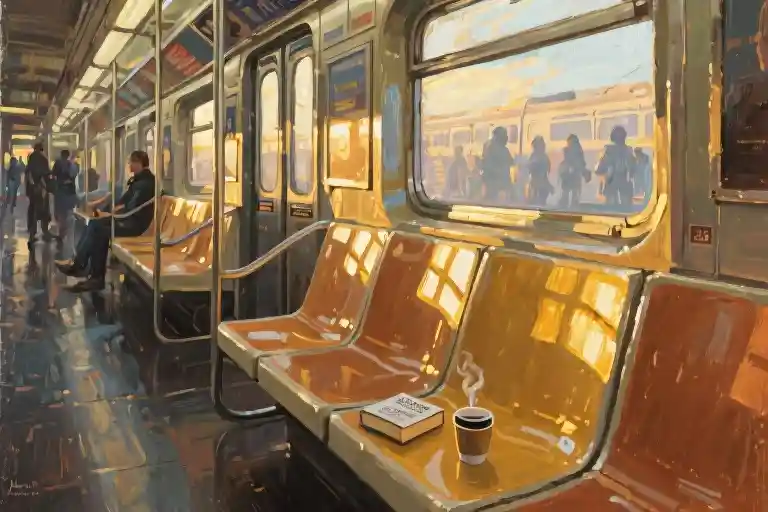The morning train hums with unremarkable life. A college student’s head bobs gently against the fogged window, her eyelashes casting shadows in the winter light. Two seats down, a man in a wrinkled suit thumbs through a paperback, its spine creased from countless commutes just like this one. Through the glass, a woman adjusts her scarf three times before the platform disappears behind us—a tiny drama unnoticed by anyone but the pigeons pecking at discarded toast.
These aren’t the scenes we post about. They don’t make the curated reels or the anniversary slideshows. Yet here they are, these quiet fragments of existence, stitching together what we’ll one day call ‘a life.’ The truth we so often miss? Those milestone moments—the promotions, the proposals, the passport stamps—are merely punctuation marks in a story written mostly in lowercase letters.
Consider this: if Nietzsche’s eternal recurrence were real, and you had to relive this ordinary Tuesday indefinitely—the lukewarm coffee, the missed bus, the way afternoon light slants across your desk at 3:17pm—would you search for new meaning in these supposedly insignificant details? The philosopher’s thought experiment isn’t about grand destinies, but about the texture of our daily bread. What if the meaning we chase isn’t ahead of us, but already here in the subway’s rhythmic sway, in the barista remembering your usual order, in the dog-eared pages of a journal filled with grocery lists?
Modern life has trained us to overlook these moments. Our brains, wired for efficiency, filter out the ‘unimportant’—the pattern of rain on office windows, the weight of a well-worn keychain, the particular way a loved one clears their throat before speaking. We’ve developed what psychologists call ‘inattentional blindness,’ scrolling past our own lives while waiting for something ‘special’ to happen. But as Kierkegaard warned, this is how we sleepwalk through our days, mistaking existence for living.
The train slows. Someone’s shopping bag tips over, sending oranges rolling down the aisle. A teenager catches one mid-stride and tosses it back with a grin. No cameras flash. No one will remember this tomorrow. But right now, in this unclaimed moment between stations, there’s a fleeting masterpiece of human connection—the kind John Dewey called ‘art as experience’ when ordinary actions become extraordinary through simple presence.
Perhaps intentional living begins here: not in chasing mountaintop epiphanies, but in noticing how sunlight warms the subway tiles in geometric patterns. Not in waiting for life to become remarkable, but in recognizing it already is.
The Age of Blindness: How Social Media Reshaped Our Perception of Meaningful Moments
The glow of smartphone screens has become the campfire around which we gather to share our stories. But somewhere between the perfectly staged brunch photos and the curated vacation highlights, we’ve developed a collective myopia – an inability to see the beauty in life’s unedited moments. This visual impairment isn’t physical but cognitive, trained into us by algorithms that reward spectacle over substance.
The Highlight Reel Paradox
Cognitive scientists call it ‘salience bias’ – our brain’s tendency to prioritize flashy, emotionally charged information while filtering out the mundane. In prehistoric times, this helped us spot predators in the brush. Today, it makes us scroll past hundreds of ordinary moments in search of that next dopamine hit from an extraordinary post. The average Instagram user now encounters 30% more ‘peak life moments’ in a day than their grandparents did in a year, creating distorted expectations about how life should feel.
This neurological wiring explains why we remember our anniversary dinner at that Michelin-starred restaurant but forget the quiet comfort of Tuesday night spaghetti. The extraordinary imprints itself on our memory while the ordinary slips through like sand. Yet when researchers at Harvard tracked emotional states, they found people derive more cumulative happiness from daily routines than from intermittent highs. That morning coffee ritual with your partner contributes more to life satisfaction than the annual vacation you post about.
Wedding Bells vs. Breakfast Dishes
Consider the modern wedding industry – a perfect case study in our cultural obsession with pinnacle moments. Couples now spend an average of $30,000 to choreograph a single day’s perfection while often neglecting the daily practices that sustain marriages. The psychological contrast is revealing: wedding photos show beaming smiles in designer clothes, while marital happiness actually lives in the unphotographed moments – the shared laughter over burnt toast, the silent understanding when one takes over dish duty without being asked.
Psychologist Robert Epstein’s longitudinal study of couples found that those who documented ordinary interactions (like grocery shopping together or fixing a leaky faucet) reported higher relationship satisfaction than those who focused only on capturing special occasions. The act of valuing mundane moments created a feedback loop that enhanced their perception of daily life. Meanwhile, the social media effect works in reverse – the more we consume others’ highlight reels, the more our own lives feel inadequate by comparison.
Rewiring Our Perception
The solution isn’t abandoning technology but developing what philosopher Simone Weil called ‘attention as a form of prayer.’ This means:
- Creating space between stimulus and response – When you feel the urge to reach for your phone during a dull moment, pause. Notice how discomfort with stillness drives this impulse.
- Practicing peripheral vision – Literally soften your gaze to take in more of your surroundings. Metaphorically, this means noticing background details: the way light slants across your desk at 3pm, the particular sigh your dog makes when settling into sleep.
- Collecting mundane artifacts – Start a ‘boring beauty’ album in your phone for images that would never get likes: a half-peeled orange, your work badge on the dresser, rain droplets on your windshield.
Neuroscience confirms that this intentional noticing physically alters our brains. A 2022 Cambridge study found that participants who kept ‘ordinary moment journals’ for eight weeks developed increased gray matter in the anterior cingulate cortex – the region associated with present-moment awareness. Their brains literally grew new capacity to appreciate daily life.
Like adjusting to a dark room after bright lights, retraining our perception takes time. But gradually, we begin to see what was always there: the poetry in a subway delay, the intimacy in folding laundry together, the quiet heroism of showing up day after day. These unspectacular moments don’t just fill the gaps between highlights – they are the very fabric of a life fully lived.
The Invitation of Eternal Recurrence
That crumpled receipt in your pocket? The half-empty coffee cup left on your desk? The way sunlight slants across your kitchen floor at 4:32pm? These unremarkable fragments contain more truth about living than any highlight reel ever could. Nietzsche understood this when he proposed his most unsettling thought experiment – what if you had to relive this exact life, with all its mundane repetitions, for eternity?
Nietzsche’s Wake-Up Call
The German philosopher wasn’t suggesting we’re trapped in literal repetition. His eternal recurrence concept serves as the ultimate litmus test for intentional living. When we ask ourselves “Could I bear to live this moment again and again?”, we’re forced to examine the quality of our ordinary days. That Tuesday commute, the weekly grocery run, the predictable evening routine – these aren’t just filler between important events. They are the substance of existence itself.
Consider your morning ritual. The way you brew coffee while still half-asleep, the familiar weight of your favorite mug, the steam rising in predictable swirls. Under Nietzsche’s lens, this isn’t just habit – it’s a daily opportunity for presence. His philosophy transforms the ordinary into sacred ground by asking: Would you want this moment etched into eternity?
Kierkegaard’s Sleepwalkers
While Nietzsche urges us to embrace repetition, Kierkegaard warns against drifting through life on autopilot. His concept of “sleepwalking” describes how we often move through days without truly inhabiting them. That automatic commute where you arrive without remembering the journey? The meals eaten while scrolling? These are symptoms of what Kierkegaard called “forgetting to exist.”
The antidote lies in what he termed “repetition” – not mindless recurrence, but conscious re-engagement with daily experiences. It’s the difference between mechanically stirring your afternoon tea and noticing how the honey dissolves in slow golden ribbons. Both philosophers point us toward the same truth: significance isn’t found by escaping the ordinary, but by diving deeper into it.
Dewey’s Kitchen Epiphanies
John Dewey took this further by demolishing the artificial divide between art and life. In “Art as Experience,” he argues that aesthetic moments aren’t confined to museums – they happen when we fully engage with any activity. The rhythmic chopping of vegetables can become a meditation. The play of shadows across your workspace transforms into living composition. Even washing dishes, when approached with attention, becomes an act of creation.
Dewey’s philosophy manifests practically in what I call “kitchen sink mindfulness” – finding artistry in domestic routines. Notice tomorrow how water beads on freshly washed lettuce, how steam rises from a simmering pot in delicate spirals, how your knife makes that particular sound against the cutting board. These aren’t just tasks to complete; they’re sensory poems waiting to be noticed.
The Eternal Return of Tuesday Afternoon
Here’s how to apply these philosophies today:
- The Nietzschean Pause: When feeling impatient with routine, ask: “If I had to relive this moment forever, how would I want to experience it?” This transforms dull tasks into conscious rituals.
- Kierkegaard’s Interruption: Set three daily alarms labeled “Wake up!” When they chime, fully notice your surroundings for 30 seconds – the texture of your shirt sleeve, the quality of light, the ambient sounds.
- Dewey’s Art Assignment: Choose one mundane activity this week to approach as an artist. Document it through photos, notes, or sketches, treating it with the reverence of a gallery piece.
These thinkers invite us to a radical proposition: that meaning isn’t manufactured through grand gestures, but uncovered through daily attention. Your life isn’t happening later, after you achieve some milestone. It’s happening now – in the way your pen feels in hand, in the particular cadence of your breathing as you read these words, in the ordinary miracle that you’re here at all to experience any of it.
The Archaeology of Ordinary Moments
Method 1: Reverse Photography (Capturing the ‘Unshareable’ Corners)
Your camera roll likely bursts with sunset panoramas and birthday smiles—carefully curated moments deemed worthy of preservation. But what about the crumpled receipt on your dashboard after a grocery run? The mismatched socks piled in your laundry basket? These are the artifacts of real living, the visual footnotes we instinctively exclude from our personal highlight reels.
The Practice:
- Set your phone camera to black-and-white mode (removes distraction of color)
- Photograph three ‘unremarkable’ scenes daily:
- A partially eaten meal
- The view from your usual parking spot
- A worn household object (coffee mug stains, frayed shoelaces)
- Store these in a dedicated album titled The Between Moments
Why It Works:
Neuroscience confirms our brains prioritize novelty—that’s why we remember vacations but forget Tuesday commutes. By photographing mundane details, we force our attention systems to register what they normally filter out. Over time, these images become a counter-archive to social media’s distorted reality, proving philosopher John Dewey’s assertion that “art isn’t exceptional moments, but the quality of attention we bring to any moment.”
Method 2: Commuter Anthropology (Storytelling from Strangers’ Fragments)
That woman adjusting her scarf three seats away? She might be rehearsing a difficult conversation. The teenager clutching a dented trumpet case? Perhaps his first day at music school. Every commute contains dozens of unwritten short stories.
Field Guide:
- Visual Clues: Look for:
- Worn items (shoes, watch straps)
- Unconscious gestures (tapping patterns, hair-twisting)
- Contradictions (formal attire with cartoon socks)
- Audio Notes: Record overheard dialogue snippets in a voice memo app
- The 3-Sentence Rule: Before your stop, compose a micro-story about one person using:
- An observed detail
- A hypothetical backstory
- An imagined next step
This exercise isn’t about accuracy—it’s about breaking our habitual blindness to the human theater unfolding daily around us. As Kierkegaard observed, “Boredom is the root of all evil—the despairing refusal to be oneself.” By engaging our narrative instincts, we transform idle observation into active meaning-making.
Method 3: Sensory Journaling (The Forgotten Alphabet of Experience)
We navigate life visually, yet smell triggers memory 100x more powerfully. Touch receptors outnumber taste buds 200:1. This method reconnects us with neglected senses.
Daily Prompts:
- Monday: Document a texture (peeling paint, cat’s tongue)
- Wednesday: Note a temperature shift (sun-warmed handrail)
- Friday: Record a sound without naming its source (rustling like dry leaves)
Advanced Practice:
Pair sensations with emotional weather reports:
“The elevator’s hum at 3pm—a metallic lullaby that makes my shoulders drop half an inch.”
Scientific Backing:
MIT studies show multisensory engagement creates ‘stickier’ memories. By cataloging non-visual impressions, we build a richer mental map of our days—what Nietzsche might call “eternal recurrence insurance” against life slipping through our fingers.
Integration Challenge: The 7-Day Ordinary Archaeology Expedition
Combine all three methods into a weeklong experiment:
- Day 1-3: Practice each method separately
- Day 4-6: Create ‘artifact collages’ (e.g., a subway photo + overheard phrase + texture note)
- Day 7: Review your collection and answer:
- Which moment surprised you by its quiet significance?
- What pattern emerges about your attention habits?
This isn’t about manufacturing meaning, but uncovering what’s already there—like an archaeologist brushing dust from pottery shards to reveal they’ve been mosaic tiles all along. As poet William Blake wrote, “To see a World in a Grain of Sand…” begins with simply noticing the grain exists.
The Anti-Perfectionism Toolkit: Rewiring Your Perception of Daily Life
Tool 1: Cognitive Reframing – The ‘Undecoded Richness’ Mindset
The coffee stain on your desk isn’t just a mess—it’s a fossil of that morning rush when you laughed with your roommate about burnt toast. The supermarket receipt curling in your wallet doesn’t merely record groceries; it’s a ledger of nourishment choices that kept your body going last Tuesday. This is what we mean by ‘undecoded richness’—the practice of seeing ordinary objects as layered artifacts waiting for your interpretation.
Why This Works:
- Neurologically, our brains naturally filter out ‘unimportant’ stimuli (called habituation) to conserve energy
- Intentionally breaking this pattern activates the prefrontal cortex, enhancing presence and memory encoding
- A 2021 University of London study found people practicing this mindset reported 23% higher life satisfaction after 8 weeks
Try This Today:
- Choose one mundane object in your vicinity (a pen, a chair, a cloud)
- Ask yourself:
- What human stories are embedded here? (Who designed this? Who manufactured it?)
- What natural processes made this possible? (The tree that became paper, the oil that became plastic)
- What personal memories does it connect to? (The chair where you cried after that phone call)
- Jot down three ‘hidden layers’ you discover
Tool 2: Building an ‘Anti-Curated’ Archive
While Instagram algorithms reward polish, your private collection should celebrate raw authenticity. Start a physical/digital repository for:
- Faded train tickets with scribbled meeting notes
- Photos of mismatched socks in the laundry
- Voice memos of your unedited morning voice
- Screenshots of awkward text exchanges
Curating Principles:
- The 5-Year Rule: Would this seem precious when rediscovered half a decade later? (That crumpled napkin from your nephew’s first restaurant visit? Keep it.)
- Imperfection Metrics: Actively seek items with:
- Visible wear (dog-eared books)
- Unplanned compositions (asymmetrical dinner plates)
- Emotional transparency (angry journal entries)
Pro Tip: Use a simple shoebox or a dedicated Google Drive folder labeled ‘Real Life’—the very ordinariness of the container reinforces the philosophy.
Tool 3: Designing ‘Ordinary Glory’ Rituals
These are personalized ceremonies that sanctify routine moments. Examples from our community:
- The Threshold Pause: Before entering your home each day, stand still for 7 seconds to notice one new detail
- The Coffee Cup Epiphany: Use your morning mug as a tactile reminder to identify one unremarkable thing you’re grateful for
- The Laundry Litany: While folding clothes, mentally recount the stories behind each stain and wrinkle
Creating Yours:
- Identify a repetitive task you usually rush through (brushing teeth, waiting for the microwave)
- Attach a sensory anchor (a specific scent, texture, or sound)
- Add a simple mindfulness question (‘What’s one true thing right now?’)
The Science Behind the Tools
Recent fMRI studies show these practices:
- Increase gray matter density in the anterior cingulate cortex (associated with emotional regulation)
- Reduce activity in the amygdala (fear center) when encountering imperfections
- Create ‘attention residue’ that makes ordinary moments feel more substantive
Remember: This isn’t about manufacturing positivity, but developing what philosopher Iris Murdoch called ‘a just and loving gaze’ upon reality. Some days, that gaze will notice beauty in sunlight through dust particles. Other days, it might simply acknowledge the dignity in enduring a tedious commute. Both count.
Your Challenge This Week
- Monday-Wednesday: Collect 3 ‘anti-curated’ artifacts
- Thursday-Friday: Practice cognitive reframing during one routine activity
- Weekend: Design and test one ‘ordinary glory’ ritual
As John Dewey observed, ‘We don’t have experiences; we are our experiences.’ The coffee rings on your desk aren’t blemishes—they’re the fingerprints of a life being lived, not just performed.
The Quiet Epiphany: Returning to the Train Carriage
The fluorescent lights of the train carriage hum differently now. That same student still dozes against the window, but you notice how sunlight fractures through his glasses onto a textbook margin where he’s scribbled “call Mom” in smudged blue ink. The couple’s hushed conversation reveals itself as an earnest debate about whether to adopt a three-legged cat they saw at the shelter. The novel’s softened spine bears the ghostly imprint of its reader’s thumb at chapter seven – always abandoned, always returned to.
This is what changes when we practice intentional living: not the world itself, but our capacity to witness its unscripted poetry. The graffiti on the passing fence now reads like a haiku –
Rust and spraypaint bloom
on corrugated steel waves
summer cicadas
John Dewey was right when he argued that art isn’t confined to galleries. It’s here in the way rain beads on the window, tracing transient maps of cities you’ll never visit. In the symphony of a dozen silent passengers breathing in unison as the train rounds a curve. In the existential courage of a single crocus pushing through cracked pavement.
“Beauty is truth, truth beauty,” Keats wrote – not as romantic abstraction, but as radical instruction. The truth of our lives lives in these uncurated moments:
- The kitchen drawer with its tangled charger cords and expired coupons
- The voicemail your father left just to say he saw your favorite flower
- The way your partner always misplaces one slipper
These are the artifacts of a life fully inhabited. Not the framed graduation photos, but the coffee rings on textbooks that got you there. Not the vacation sunsets, but the way your knees still bear faint imprints of childhood scrapes.
Your Invitation to Ordinary Archaeology
Tonight, when the world tells you to chase grandeur, I invite you to this rebellion:
- Open your kitchen’s most neglected drawer
- Photograph its chaotic contents without rearranging
- Consider: What stories live here?
- The takeout menu from your first date night post-lockdown
- The broken corkscrew that witnessed three New Year’s eves
- The measuring tape that marked your child’s growth against the fridge
This isn’t an exercise in nostalgia. It’s training for what Nietzsche called “eternal recurrence” – the practice of seeing each mundane detail as infinitely repeatable and therefore infinitely precious. That sticky jam jar lid? It’s the Rosetta Stone of your domestic theology.
When you develop this quality of attention, something shifts. The train carriage becomes a moving monastery. Your cluttered desk transforms into a diorama of creative struggle. Even grief, when observed with gentle precision, reveals its hidden topography – how loss etches itself into the warp of your favorite sweater, the particular way afternoon light falls across an empty chair.
“But what if my life feels too ordinary?” you might ask. To which I’d respond: The word ‘ordinary’ comes from the Latin ordo – meaning sequence, arrangement. Your life isn’t ordinary because it’s unimportant, but because it persists in beautiful, stubborn orderliness despite cosmic chaos. That morning ritual of stirring honey into tea? That’s you asserting order against entropy’s tide.
So let us end where we began – not with a grand finale, but with the quiet continuation. The train slows at your stop. The student wakes with a start, his textbook now bearing a new marginal note: “P.S. She said yes to the cat.” The novel finds its place in a tote bag beside a slightly bruised peach. And you step onto the platform carrying this revelation:
The most extraordinary thing we can do
is show up completely
for our perfectly unremarkable days.
When tomorrow’s sun touches that same window, what will you choose to see?





